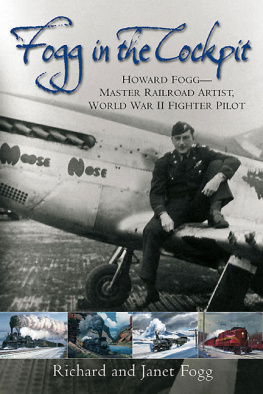One of the greatest hazards in flying is fog in the cockpit.
As told to Richard Fogg by his father Howard Fogg, this phrase was uttered by a meteorology instructor to a class of student pilots in 1942. A gale of laughter, led by Howard, followed this pronouncement.
INTRODUCTION
Described for decades as the worlds foremost railroad artist, Howard Foggs fascination for railroading began early. He sketched his first train when he was only four years old.
After graduating from Dartmouth College with honors in 1938 with a degree in English Literature, Howard attended the Chicago Institute of Fine Arts. Appreciative of the many ironies in life and politics, he hoped to pursue editorial cartooning, though he also painted, which is where his talent ultimately led him.
Howards career as an artist has been explored in radio and television interviews, magazine articles, newspapers, and books, but that is not the primary objective of this book. Here, we focus on his military service as chronicled in his personal wartime diary. Written during 1943 and 1944, it offers a unique perspective into the life of a fighter pilot with the Army Air Forces. Although principally concerned with his experiences as a pilot, it is inevitable that his love of railroading and his enthusiasm for painting is also reflected in these pages.
Drafted into the Army on May 15, 1941, Howard was assigned to the 4th Armored Division at Watertown in upper New York Statebut the December 7, 1941 Japanese attack on Pearl Harbor changed his life. The Army Air Corps needed pilots, so with his keen vision and sense of duty, Howard requested a transfer. He received basic flight training at Parks Air College in St. Louis, primary training at Vance Air Base in Enid, Oklahoma, and finished his schooling at Foster Field in Victoria, Texas.
Commissioned as a second lieutenant with pilots wings on November 11, 1942, Howards first flight assignment was at Westover Field in Springfield, Massachusetts. There, he flew P-47 Thunderbolts under the leadership of Lieutenant Colonel Avelin P. Tacon Jr., who commanded the 359th Fighter Group, comprised of the 368th, 369th, and 370th Fighter Squadrons.
Lucky Howard.
The Westover assignment allowed him to travel regularly to New York City, where he continued to court the vivacious, beautiful, and un conventionally determined Margot Dethier, daughter of a Belgian concert violinist. Smitten by Margot when they met at the Dartmouth-Yale football game in 1934, Howard patiently pursued Maggie throughout her college days, despite her initial disinterest in his romantic declamations.
Following her 1942 graduation from Bryn Mawr College, Margot accepted her own new challenge. She returned home to New York and became one of the first female railroad ticket agents, a high-pressure job requiring a prodigious memory as well as patience with those who viewed the position as one that should only be held by a man. But women were filling mens jobs all over the United States, and Margot persevered.
So did Howard.
That fall and winter Margot realized how strongly she returned Howards affections, and on April 10, 1943, they were married at the Madison Avenue Church in New York City.
After a brief honeymoon, Howards flight training again became the young pilots priority. Assigned to Grenier Field in New Hampshire, the 368th and 369th Fighter Squadrons continued their training in P-47s, though a shortage of planes limited each pilots flight time. In May, Howard was transferred to Republic Field on Long Island where his squadron received new Thunderbolts, and training intensified. Howard then returned to Westover Field in August, while Margot stayed with his parents in Summit, New Jersey. On October 1, 1943, he received his combat orders and traveled to Camp Kilmer, New Jersey to await his transfer overseas.
Richard Fogg and Janet Fogg

Captain Howard Fogg. Courtesy of Richard Fogg
We begin this transcription with a note penned by Howard on a Memoranda page within the diary.
Smorgasbord
This is not intended to be the intimate lock and key type of diary, but rather a cumulative digest of events, incidents, and personalities recorded by date and concerning the 368th Fighter Squadron, and especially D Flight. No style, no planned form, merely enough notes to refresh the authors dull memory should that anticipated day of writing a book ever, by good fortune, arrive and become an actuality. Personal philosophizing and opining will colour much of the record, and why not, since any facts are made human and alive and vibrant by the personal touch, be it biased or open-minded.
Howard Fogg

Fogg Mission Destinations Map. Western Europe in 1944. By Janet Fogg
Friday, October 1: Westover Field, Massachusetts Oh memorable of all Fridays when, unwittingly, and with promises of seeing her in Summit soon, I gaily kissed Margot farewell for the last time prior to shipping. Of course wed have time off from Westover Field. Yes? Who dreamt that a week from tonight wed be on the high seas Europe bound, with the family still waiting in Summit. Such is fate. But perhaps it was easier this way. No parting tears. No grief of certain parting. In any event, all was excitement and confusion as we prepared to board the train for Kilmer. Nineteen cars and B&M (Boston & Maine railroad) #4114 at 2:30 A.M. All aboard!
















